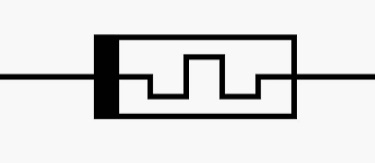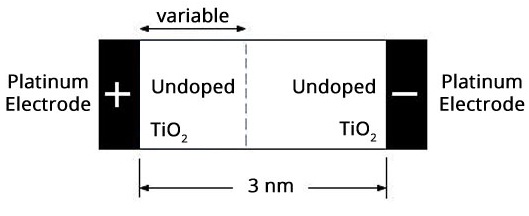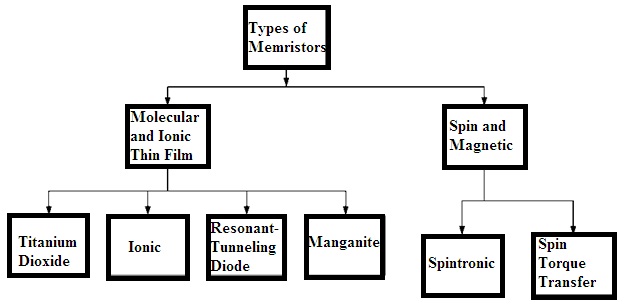Resistors, Inductors, and Capacitors are considered as the basic components of electronic systems. Further, the research has been carried out by Leon Chua in the year 1971. He was a professor at UC Berkely. He was always enthusiastic about knowing why electronic devices or systems are restricted only to linear characteristics. He carried out researches and studied non-linear characteristics of these basic elements and added the fourth element known as a memristor. Because resistors define the characteristics of current and voltage, inductors are for determining current and the flux characteristics, capacitors for defining charge, and voltage characteristics. But there is a missing relation between the charge that is moving in a circuit and the flux enclosed by it. This relation is described by Chua and termed it as characteristics of a memristor. Linking the charge and the magnetic flux is the theory behind this memristor.
What is Memristor?
A two-terminal electronic component that possesses non-linear characteristics and relates the electric charge with the magnetic flux generated by the circuit is defined as a memristor. The word memristor hints the combination of memory with a resistor. It possesses the dynamic relation amid voltage and current and with a memory that consists of the history of past applied currents or voltages. The units of this element resistance are measured in terms of ‘ohms’.

Memristor Symbol
Construction and Working of Memristor
It is a device that comprises two terminals and the resistance of this element is based on the polarity, duration of time and the magnitude of the voltage applied.

Memristor Construction
The construction and the working of memristor can be done by following these steps:
- Take an element that has resistive properties. Here we are considering titanium dioxide.
- This material is placed between the two electrodes made of platinum.
- The internal section is divided into two parts one side is doped titanium dioxide and the other side is left undoped. The doped section is a variable one.
- The voltage is applied across the electrodes. The oxygen atoms present starts diffusing and the direction is dependent upon the polarity of the voltage applied.
- Due to this the solid gets thicker or thinner and produces a change in the value of resistance.
- It can store the past output history until the voltage is applied.
Consider an example of the water flowing through a pipe. Water flow can be compared to the electric charge. If the diameter of the pipe is less it is more resistant to the flow of charge. The circuit designing in the past has the fixed diameter but the introduction to memristors makes it to dynamic based on the charge flow. Above all, the freezing property of memristors is suitable for computer memory.
Types of Memristors
Practically there exists no information or datasheets regarding these memristors. Still based on design and material used for construction memristors are classified into two types. They are:

types-of-memristors
Molecular and Ionic Thin-film Memristors
These rely on the different properties exhibited by the material and in which the hysteresis is initiated after the charge incorporated in it.
Memristors Made with the Titanium Dioxide
This type of memristor is made with titanium dioxide. the hysteresis will be occurring due to the transfer of the oxygen between the layers once charged.
Ionic
Generally, ions are of two types anions and cations and any ion can carry the charge and move from one place to another in any direction when they are in solid-state. The concept of dynamic doping is utilized for initiating the hysteresis in the material. It requires a single layer that is passive in between the electrode and the active material will be a polymer. This material forces the ions to make a move from the electrode to the film. It is based on the ‘Electrolytic process’.
Manganite
The construction and functionality are similar to titanium dioxide. The only difference is instead of titanium dioxide the film of manganite oxide is used.
Resonant-Tunneling diode
Multiple ‘quantum-well diodes‘ are utilized so that it can utilize dynamic doping and can generate hysteresis among the film layers.
Magnetic Effect and Spin Technology
These are developed by using the technology called ‘degrees of freedom’. When the electron spins its polarization is controlled by the magnet moving which is separated by the poles and hysteresis is generated.
Spintronic
The functionality of this technology is similar to titanium dioxide memristors. In this, the direction of the spinning electron can be changed by using a movable magnet and due to this hysteresis is generated amid the devices.
Spin Torque Transfer
MRAM is a memristive component by nature. The Spin Valve Technology of MRAM generates hysteresis. The resistance can be varied by this technology and the current is induced through the junction made up of magnets. Based on the material chosen this MRAM exhibits the magnetic and the ionic characteristics.
Three-terminal Memristors
Bernard widrow in the year 1960 designed a memristor with three terminals by using the technology called ‘Electroplating’. The hysteresis is generated by ‘non-solid states’. The conduction of the system is controlled by the time integration of the current.
Memristor Advantages and Disadvantages
The advantages of this memristor are as follows:
- These elements utilize power when the device is active similar to ‘non-volatile memory’. Hence these are power conservant.
- speed and the storage capacity is high.
- Less energy is utilized and the less heat is generated.
- It is useful in creating analog computers that are faster in comparison to digital computers.
- Density gives a provision to store the excess information.
- Fast boot-up is provided so the information is not lost when the device gets turned OFF.
The disadvantages of this memristors are:
- The performance and the speed of memristors don’t match the speed of DRAM and transistors.
- Commercially these are not available.
FAQs
1). Why is a memristor used for?
It can be used as a switch so that the multiple inputs and the outputs can be connected in the matrix. It is also referred to as a ‘Matrix Switch’. It is also used in logic circuits, biological systems, neuromorphic systems, digital memory systems, and low power applications.
2). What is memristor technology?
It is a kind of electrical component which determines the linkage between the magnetic flux generated across the circuit due to the movement of charge in it. This is referred to as memristor technology.
3). What is memristance?
It is one of the electronic components. If the flow of charge is in one direction then the resistance in such cases increases. If the flow of charges is in opposite directions results in a decrease in resistance. If the supply of voltage is halted then the circuit remembers the value o past resistance and continues with the recent value of once the supply is provided.
4). Why is memristance important?
The circuits are comprising each day and the concept of memristance is getting stronger. As nanotechnology is taken into account to simulate and the design of electronic circuits requires memristance.
Memristors have the capability of storing the history of applied inputs and obtained outputs. Non-volatile memories in the next generation can be manufactured using these memristors. By combining these elements with transistors can form a hybrid circuit which has the capability of enhancing the performance of digital circuits. Can you describe any further practical implementation of memristors?